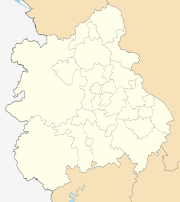Newcastle-under-Lyme
| Newcastle-under-Lyme | |
|---|---|
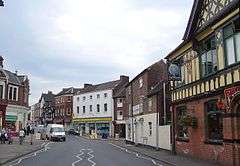 | |
 Newcastle-under-Lyme Newcastle-under-Lyme shown within Staffordshire | |
| Population | 128,264 |
| OS grid reference | SJ848459 |
| District | |
| Shire county | |
| Region | |
| Country | England |
| Sovereign state | United Kingdom |
| Post town | NEWCASTLE[1] |
| Postcode district | ST5 |
| Dialling code | 01782 |
| Police | Staffordshire |
| Fire | Staffordshire |
| Ambulance | West Midlands |
| EU Parliament | West Midlands |
| UK Parliament | |
Newcastle-under-Lyme (/ˌnjuːkɑːsəl-/ NEW-kahss-əl-, locally /-kæs-/ -kass-; or Underlem /ˈʌndərləm/, cf. Burslem, Audlem), is a market town[2] in Staffordshire, England, and is the principal settlement in the Borough of Newcastle-under-Lyme. In the 2011 census the town had a population of 128,264.[3]
History
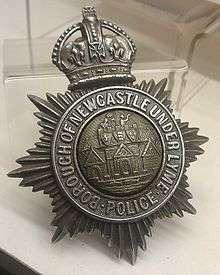
Etymology
The "Newcastle" part of the name derives from being the location of a new castle in the 12th century. [4] The "Lyme" section could refer to the Lyme Brook or (as in the lastname: Lindhurst) the extensive Forest of Lyme that covered the area with lime trees in the Middle Ages.[4][5] The well-known Berlin street Unter den Linden is a cognate of 'under-Lyme'
12th–19th centuries
Newcastle is not mentioned in the Domesday Book, as it grew up around the 12th century castle, but it must have rapidly become a place of importance because a charter, known only through a reference in another charter to Preston, was given to the town by Henry II in 1173. The new castle was built to supersede an older fortress at Chesterton about 2 miles (3 km) to the north, the ruins of which were visible up to the end of the 16th century.
In 1235 Henry III constituted it a free borough, granting a guild merchant and other privileges.[4] In 1251 he leased it at fee-farm to the burgesses. In 1265 Newcastle was granted by the Crown to Simon de Montfort, and subsequently to Edmund Crouchback, through whom it passed to Henry IV. In John Leland's time the castle had disappeared "save one great Toure".
Newcastle did not feature much in the English Civil War, save a Royalist plundering.[2] However, it was the hometown of Major General Thomas Harrison a Cromwellian army officer and leader of the Fifth Monarchy Men.
The governing charter in 1835[4][6] which created the Newcastle-under-Lyme Municipal Borough absorbed the previous borough created through the charters of 1590 and 1664, under which the title of the corporation, was the "mayor, bailiffs and burgesses of Newcastle-under-Lyme."[4]
Newcastle sent two members to parliament [7] from 1355 to 1885, when it lost one representative.
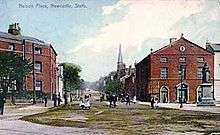
20th century
When Stoke-on-Trent was formed by the 1910 amalgamation of the "six towns" (Stoke, Hanley, Fenton, Longton, Burslem and Tunstall) Newcastle remained separate. Despite its close proximity, it was not directly involved in the pottery industry, and it strongly opposed attempts to add it in 1930[8] with a postcard poll showing residents opposing the Stoke-on-Trent Extension Bill by a majority of 97.4%. Although passed by the House of Commons, the Bill was rejected by the House of Lords.[2]
Following the Local Government Act 1972 it became the principal settlement of the Borough of Newcastle-under-Lyme.
Economy
Like neighbouring Stoke-on-Trent, Newcastle's early economy was based around the hatting trade, silk and cotton mills. Later coal mining, brick manufacture, iron casting and engineering rose to prominence.[4] Very fine red earthenware and also soft-paste porcelain tableware (the first such production in Staffordshire) was produced in Newcastle at Samuel Bell's factory in Lower Street between 1724 and 1754 when all production ceased. With the exception of a failed enterprise between 1790 and 1797, which then switched to brewing, there was no further commercial production of pottery within the town of Newcastle. Production of earthenware tiles however continued at several locations within the borough. Manufacture of fine bone china was re-established in the borough in 1963 by Mayfair Pottery at Chesterton.
The manufacture in the borough of clay tobacco smoking pipes started about 1637 and grew rapidly and was second only to hatting within the borough. Nationally, the town was ranked with Chester, York and Hull as the four major pipe producers. This industry continued until the mid-19th century when decline set in rapidly and by 1881 only one tobacco pipe maker was left.
In the 17th, 18th and 19th centuries the town had a flourishing felt hat manufacturing industry,[4] which was probably at its peak locally in the 1820s, when a third of the town's population were involved in over 20 factories, but by 1892 there was only one manufacturer still in production.
In 1944, the Rolls-Royce Derwent engine for the Gloster Meteor fighter was made in the borough.
Newcastle's 20th-century industries include: ironworking, construction materials, clothing (especially military, police and transport uniforms), computers, publishing, electric motors and machinery.
Near the turn of the 20th and 21st centuries, the town received major redevelopment to incorporate a new street (Castle Walk) into the town centre, providing Newcastle with a new bus station and bringing in more companies. Various business centres in the town provide offices for companies that operate in the service sector.
A dwindling number of pubs, clubs and bars provide Newcastle with a relatively strong night life, with students' night being on Thursdays; this aspect of Newcastle has arguably eclipsed the shopping and market town it once was.
Politics
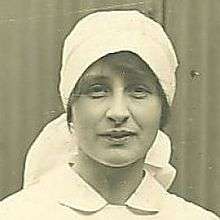
The town has been the birthplace of several notable politicians and activists. Fanny Deakin was a campaigner for better nourishment for babies and young children and better maternity care for mothers. The former chairwoman of Campaign for Nuclear Disarmament (CND), Janet Bloomfield (née Hood) is a peace and disarmament campaigner. Vera Brittain writer, feminist (and mother of Liberal Democrat Shirley Williams) was born in the town.[9]
There have been two particularly notable Members of Parliament (MPs). Josiah Wedgwood IV was a Liberal, Independent and Labour Party MP, who served as Chancellor of the Duchy of Lancaster in the cabinet of Ramsay MacDonald, in the first ever Labour government. He was an MP from 1909 to 1942. John Golding was elected as a Labour MP for Newcastle-under-Lyme at a by-election in 1969. He served in the governments of Harold Wilson and Jim Callaghan, as PPS to Eric Varley as Minister of Technology, a Labour whip in opposition, and Minister for Employment, stepping down in 1986.[10]
The current MP is Paul Farrelly.
Transport
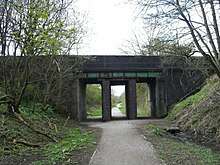
The town was once served by the North Staffordshire Railway, its station being on a branch line from Stoke-on-Trent via Newcastle, Silverdale and Keele, to Market Drayton in Shropshire. Newcastle-under-Lyme railway station opened in September 1852, after numerous construction difficulties involving the two tunnels of 605 yards (553 m) and 96 yards (88 m) respectively at Hartshill. There were also two halts to the west of Newcastle railway station, located at Brampton and Liverpool Road.[11]
The section from Silverdale to Market Drayton closed to passengers in May 1956 and the rest of the line in March 1964. Only small sections remained from Madeley to Silverdale, and from Silverdale to Holditch, for coal traffic from the local collieries. The line from Newcastle Junction to Silverdale has been removed, with the site of Newcastle railway station and the Hartshill tunnels being filled in.
Newcastle was on the national canal network, but the Newcastle-under-Lyme Canal, running from the Trent and Mersey Canal at Stoke-on-Trent to Sir Nigel Gresley's Canal has been disused since 1935 and most of it filled in.
Geography and climate
Situated in a valley alongside the Lyme Brook, the town is immediately west of the neighbouring city of Stoke-on-Trent, its suburbs running into those of the city. Newcastle town centre is just 2 miles (3 km) from Stoke-upon-Trent and less than 4 miles (6 km) from Stoke-on-Trent City Centre (Hanley). Newcastle-under-Lyme is about 17 miles (27 km) north of the county town of Stafford.
These are the average rainfall and temperatures from the Met Office weather station at Penkridge, some 24 miles (39 km) to the south. They show the averages from 1971 to 2000.
| Climate data for Penkridge, Staffordshire | |||||||||||||
|---|---|---|---|---|---|---|---|---|---|---|---|---|---|
| Month | Jan | Feb | Mar | Apr | May | Jun | Jul | Aug | Sep | Oct | Nov | Dec | Year |
| Average high °C (°F) | 6.5 (43.7) |
6.9 (44.4) |
9.5 (49.1) |
12.0 (53.6) |
15.7 (60.3) |
18.4 (65.1) |
21.1 (70) |
20.8 (69.4) |
17.5 (63.5) |
13.5 (56.3) |
9.5 (49.1) |
7.4 (45.3) |
13.3 (55.9) |
| Average low °C (°F) | 1.0 (33.8) |
1.0 (33.8) |
2.5 (36.5) |
3.5 (38.3) |
6.2 (43.2) |
8.9 (48) |
11.1 (52) |
10.9 (51.6) |
9.0 (48.2) |
6.4 (43.5) |
3.3 (37.9) |
1.8 (35.2) |
5.5 (41.9) |
| Average rainfall mm (inches) | 62.7 (2.469) |
44.4 (1.748) |
51.2 (2.016) |
48.5 (1.909) |
52.7 (2.075) |
59.3 (2.335) |
46.7 (1.839) |
57.7 (2.272) |
63.6 (2.504) |
60.5 (2.382) |
62.0 (2.441) |
66.8 (2.63) |
676.0 (26.614) |
| Mean monthly sunshine hours | 45.3 | 59.0 | 89.9 | 129.9 | 179.5 | 160.8 | 183.5 | 168.6 | 122.1 | 94.6 | 58.5 | 38.4 | 1,330.1 |
| Source: "Climate averages – Penkridge". Met Office. Archived from the original on 2 June 2007. | |||||||||||||
Green belt
Newcastle, along with Stoke, form the main urban area at the centre of the surrounding Stoke-on-Trent Green Belt, which is an environmental and planning policy that regulates the rural space in Staffordshire.[12] It is in place to prevent urban sprawl and minimise convergence with outlying settlements. First defined in 1967,[12] the vast majority of area covered extends into the wider borough, but there are some landscape features and places of interest within that are covered or surrounded by the designation, these include the Michelin Sports Facility, Newcastle golf course, Keele University, Apedale Winding Wheel, Watermills Chimney, and Bignall Hill. The West Coast Main Line forms the western boundary for the green belt.
Demography
| Comparative Census Information | |||
|---|---|---|---|
| 2001 UK Census | Newcastle-under-Lyme | Borough[13][14] | England |
| Total population | 73,944 | 122,030 | 49,138,831 |
| White | 97.8% | 98% | 91% |
| Asian | 0.6% | 0.6% | 4.6% |
| Black | 0.2% | 0.2% | 2.3% |
| Christian | 78.2% | 78.5% | 72% |
| Muslim | 0.7% | 0.5% | 3.1% |
| Hindu | 0.2% | 0.2% | 1.1% |
| No religion | 14% | 13.1% | 15% |
| Unemployed | 2.3% | 2% | 3.3% |
Of the 73,944 residents recorded in the 2001 census, 51.7% (38,210) were female and 48.3% (35,734) male.[15] 78.2% (57,819) stated their religion was Christian, with 12.9% (9,570) saying they had no religion. Muslim, Jewish, Buddhist and Sikh all recorded less than 1% of the population. 97.8% of the population defined themselves as white, with the balance being mixed race (0.6%), Indian (0.4%), Pakistani (0.2%), black (0.2%), Chinese (0.2%) with other ethnic groups forming 0.4%.[15]
62.2% (21,586) of the population work full-time and 19.4% (6,746) part-time.[16] The largest employment types are manufacturing with 7,058 (21.5%), wholesale and retail 6,157 (18.7%), health and social work 4,097 (12.5%) and financial, real estate and business activity 3,823 (11.6%).[16]
Jewish residency of the area stretches back into the 19th century.[17] In 1873 they purchased an old Welsh chapel to be used as a synagogue. In 1923 a new synagogue was built in Hanley. This was closed in 2004 and the congregation moved to a smaller synagogue in Newcastle.[18]
Transport
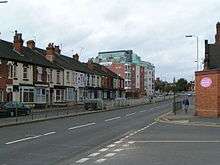
Newcastle-under-Lyme is served by the M6 motorway to the south and west of Newcastle and by the A500 road to the north and east. There are access points from the M6 at junctions 15 and 16, to the south and north respectively. The A34 trunk road runs through Newcastle from north to south and was the main road between Birmingham and Manchester until the M6 motorway opened. There is a large bus station in the town centre.
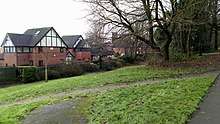
Newcastle-under-Lyme railway station, which was not within the town but towards Water Street on the Stoke to Market Drayton Line, closed in 1964 due to the Beeching cuts. The line from Silverdale to Pipe Gate remained open to serve Silverdale Colliery and a creamery at Pipe Gate until 1998 when the line closed to all stone and mineral traffic. The line forms part of a greenway from Silverdale to Newcastle-Under-Lyme with the station site now being called "Station Walks". The nearest station to the town is Stoke-on-Trent railway station which is between the town centre of Newcastle and city centre of Stoke-on-Trent and serves the Potteries as a whole.
Most of the bus network is run by First Potteries Limited and D&G Bus.
Education
The town has an extensive number of both primary and secondary schools in the state-funded sector. Secondary schools include Clayton Hall Academy, Newcastle Academy, St John Fisher Catholic College and Wolstanton High School. There is also a special school located in the town called Blackfriars Academy.
Newcastle-under-Lyme School is an independent school established in the 17th century whose alumni includes T. E. Hulme, John Wain and William Watkiss Lloyd. Edenhurst Prep School, founded in 1961, is situated in the residential area known as the Westlands
The town has a further and tertiary education Newcastle-under-Lyme College established in the 1966. In January 2010 the new £60 million college campus was unveiled.[19]
Keele University is situated 3 miles (5 km) west of central Newcastle.
Sites and attractions
Parks and gardens
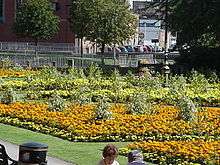
Newcastle excels in the Royal Horticultural Society Britain in Bloom competition. In 2005 it was the national winner in the "small city/large town" category (35K-100K).[20] The town features several parks including the Queen's Gardens at the eastern end of Ironmarket, which was awarded the Britain in Bloom Judges' Award for Horticultural Excellence in 2003.[21] Queens Gardens now contains the statue of Queen Victoria which was funded by Sir Alfred Seale Haslam and was unveiled by Grand Duke Michael Mikhailovich of Russia on 5 November 1903. It is the only park within the ring road.
Grosvenor Gardens in the centre of one of the town's roundabouts, hidden away below road level. Queen Elizabeth Garden is located outside the town centre and is to undergo refurbishment using National Lottery Heritage Fund money.[22]
To the north west of the town centre is Brampton Park, home to the museum and art gallery.[23]
Traditional market

Dating back to 1173 Newcastle's market, known as the Stones, operates on the High Street.[24] The market was originally held on Sunday; in the reign of John it was changed to Saturday; by the charter of Elizabeth it was fixed on Monday. Grants of fairs were given by Edward I, Edward III and Henry VI. Today the market is open six days a week, and there are over 80 stalls. Mondays, Wednesdays, Fridays and Saturdays see a general market, on Tuesdays there is an antiques market and Thursdays are for the sale of bric-a-brac. A cattle and livestock market was held on Mondays until the early 1990s; the site of the cattle market is now a branch of Morrison's supermarket.
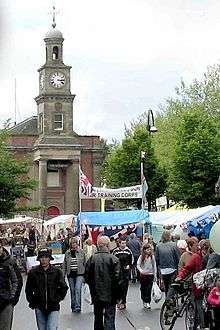
The Guildhall
The current Guildhall [25] was built in 1713 and has undergone a number of changes. Originally the ground floor was open and was used for markets, until the Market Hall was built in 1854. In 1860, in order to provide more space, the ground floor arches were bricked up and clock tower with four clocks were added. The top rooms in the Guildhall were used for meetings by the Borough council and its committees, until 1860. It is now a grade II listed building.
The Barracks
The Italian styled Militia Barracks were built in 1855 from red brick. The Barracks were the headquarters of the 3rd King's Own Staffordshire Rifle Regiment until 1880. In 1882 W.H. Dalton bought the Barracks and settled them in trust for use by the Rifle Volunteers of Newcastle, which became the Territorial Force in 1907. In 2002 the Barracks [26] were let to small businesses.
Pubs and clubs
There are at least four Working Men's Club in Newcastle – in Bradwell, at Cross Heath, in Silverdale and Wolstanton.
Culture
.jpg)
The New Vic Theatre was Europe's first purpose-built[27] theatre in the round. It is just outside the town centre and offers a full programme of entertainment, including modern or classic plays and concert performances.
The Borough Museum and Art Gallery [28] (Brampton Museum) [29] depicts the civic history of the Borough of Newcastle under Lyme and an authentic, life-size Victorian street-scene whilst the art gallery hosts work by local and national artists as well as travelling exhibitions.
Until 2005, there was an annual carnival held on the Spring Bank Holiday but this has been cancelled due to rising policing costs.[30]
Notable residents who contributed to the arts and entertainment include Philip Astley, founder of the modern circus.[31] Jackie Trent, the singer and songwriter, was born in the town.[32] Arnold Bennett, the novelist, playwright, and essayist, completed his schooling at the Middle School[33] and called the town Oldcastle in his Clayhanger trilogy of novels. Dinah Maria Mulock, who wrote under her married name of Mrs. Craik, lived in the town (in Lower Street and Mount Pleasant) and attended Brampton House Academy.[34]
E S Turner, the social commentator, was educated in the town.[35] Newcastle was also home to Dr. Philip Willoughby-Higson (1933 - 2012), poet, translator and historian and author of 33 books. He was the founder and president (1974–1992) of the Chester Poets, the oldest poetry group in the North West. Dr Higson was also the President of the Baudelaire Society of France from 1992 to 2012, the only Englishman ever to be honoured with the position.
Historically, the town had a strong tradition of festivities marking the start of a new municipal year.
Sport
The town is home to a wide range of sports clubs and associations. Newcastle Town F.C., an association football club currently play in the Northern Premier League First Division South. The Lyme Valley area is home to Newcastle & Hartshill Cricket Club. The largest rugby union club is Newcastle, Staffs Rugby Union Club.
Cycle Staffordshire organises many local cycling events as does the Newcastle Track Cycling Association. The town has its own velodrome used by the Lyme Racing Club [36] which is a popular local cycle club with over 150 members with and increasing junior membership. The club is active in many areas of cycling including time trials, track racing, road racing, Audax riding, mountain biking as well as regular Sunday club runs and general leisure cycling.
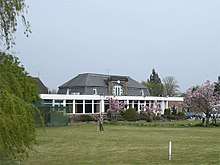
Newcastle Athletic Club [37] is based at the Ashfield Road track, next to Newcastle College. It was built in 1964 and is an ash track. The club competes in North Staffs XC League, Local, National and Heart of England League 3.
The town is also home to one of the largest and most successful volleyball clubs in England, Newcastle (Staffs) Volleyball Club, which was established in 1980 and has teams playing in the National Volleyball League, producing numerous England and Great Britain international players over the years. The college is home to Castle Korfball Club,[38] one of the nation's oldest such clubs.
There are golf courses at Kidsgrove, Wolstanton,[39] Keele[40] and at the Westlands.[41]
Keele University is home to one of the UK's first quidditch teams, the Keele Squirrels.[42]. Hosting the first ever Quidditch game in the UK in 2011 against the Leicester Thestrals
Religion
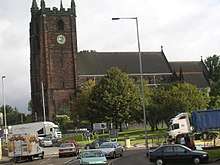
The town has a long religious history. It was the birthplace of John James Blunt, a divine and Anglican priest. Josiah Wedgwood was a Unitarian and he and his family attended meetings at the Old Meeting House, adjacent to St. Giles' Church, which is still in use for this purpose.
The town itself has a large number of Anglican churches, including St. Giles' Church,[43] the mediaeval parish church dating from 1290. There are also several Catholic churches, most notably [44] Holy Trinity,[45] whose style is Gothic in blue engineering bricks, described as ..."the finest modern specimen of ornamental brickwork in the kingdom" at the time.
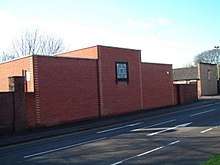
In the 18th century John Wesley made repeated visits to the area,[46] which was becoming more industrialised. He recruited many residents to Methodism. This is reflected in the large number of Methodist churches.[47] There is a Baptist church in Clayton.[48]
Of interest also is the Church of Jesus Christ of Latter-day Saints (LDS Church), located across from the Brampton Park, which serves as the 'Stake Centre' for the church in the region and has an on-site Family History Centre, where the public can research their ancestry at little or no charge.
International network
The town is part of a worldwide network of towns and cities with the name Newcastle.[49] These include more well-known Newcastle upon Tyne (also in England), Neuburg an der Donau (Germany), Neuchâtel (Switzerland), Neufchâteau (France), New Castle, Indiana (US), New Castle, Pennsylvania (US), New Castle, Delaware (US), Newcastle, KwaZulu-Natal (South Africa) and Shinshiro (Japan).
This small international network of just eight towns, formed in 1998, is designed to encourage friendship and co-operation between the towns and to this end a school in the South African town benefited in 2004 from gifts of computing equipment surplus to Newcastle-under-Lyme's needs. The annual Newcastles of the World Summit was held in Newcastle-under-Lyme for six days from 17 June 2006.[50]
![]()
![]()
![]()
![]()
Notable people
Earlier centuries
- Humphrey Wollrich (1633–1707) English Quaker writer [51]
- Philip Astley, (1742–1814) equestrian, circus owner,[52] inventor and father of the modern circus
- Silvester Harding (1745–1809) English artist and publisher,[53] who aged 14 ran away and joined a company of strolling actors
- John James Blunt (1794–1855) English Anglican[54] priest. His writings[55] included studies of the early Church.
19th century
- Henry Moseley (1801–1872) English churchman,[56] mathematician, and scientist.
- Joseph Mayer (1803–1886) English goldsmith,[57] antiquary and collector
- Emma Darwin (née Wedgwood), (1808–1896) granddaughter [58] of Josiah Wedgwood and wife of Charles Darwin
- Hungerford Crewe, 3rd Baron Crewe FSA, FRS (1812–1894) English landowner and peer,[59] inherited the Jacobean mansion of Crewe Hall and unsuccessfully opposed the construction of a Silverdale and Madeley Railway Company line
- Edward Stringer, (1819–1863) convict and prospector, discovered the Walhalla, Victoria goldfield in Australia [60]
- Sir Oliver Lodge, (1851–1940) physicist,[61] inventor and writer
- Arthur Howard Heath TD (1856–1930) industrialist, cricketer, Rugby Union international and local[62] Conservative MP
- Sir Joseph Cook, GCMG, PC (1860 in Silverdale – 1947) worked in the local coal mines,[63] emigrated to Australia in 1885, Prime Minister of Australia from 1913 to 1914
- Grand Duke Michael Mikhailovich of Russia, (1861–1929) lived[64] in Keele Hall from 1900 to 1909
- Arnold Bennett, (1867–1931) writer [65]
- Ada Nield Chew (1870–1945) suffragist.
- Alfred Herbert Richardson, (1874–1951) policeman and Chief Constable of Newcastle-under-Lyme 1901/1903
- Oliver William Foster Lodge (born Newcastle 1878 - 1955), poet and author
- Fanny Deakin (1883 in Silverdale – 1968) local politician,[66] campaigned to improve nourishment of children and maternity care for mothers.
- Vera Brittain, (1893–1970) author,[67] reformer and pacifist and mother of Shirley Williams
- Reginald Mitchell, (1895–1937) aeroplane designer [68] of the Spitfire
20th century
- E. S. Turner, (1909–2006) freelance journalist [69] and author went to school in the town.
- Fred Kite, (1921–1993) only Second World War British soldier [70] to receive the Military Medal three times
- Freddie Garrity (1936–2006), singer,[71] frontman in Freddie and the Dreamers, lived in the town[72] near the end of his life.
- Jackie Trent, (1940–2015) singer,[73] songwriter and actress
- Neil Baldwin, (born 1946) clown, former Stoke City kit-man and honorary graduate of Keele University
- Kevin John Dunn, (1950–2008) the twelfth[74] Roman Catholic Bishop of Hexham and Newcastle
- Professor Alan Sinclair (born 1952) clinical scientist[75] and diabetes specialist from Newcastle-under-Lyme
- Dylan Waldron (born 1953) artist [76] who works in tradition techniques such as painting in egg tempera and silverpoint
- Janet Bloomfield, (1953–2007) peace and disarmament campaigner
- Fran Unsworth, (born 1957) journalist,[77] Head of BBC News since January 2018 [78]
- Emma Amos, (born 1967) actress[79]
- Andrew Van Buren, Illusionist Showman Performer, co-founder of The Philip Astley Project
- Hugh Dancy, (born 1975), actor[80]
- Dan Croll, (born 1990) singer-songwriter[81]
- Leon Cooke, (born 1991) actor,[82] singer and dancer
Notables in sport
- Dick Ray (1876–1952) professional footballer and manager,[83] played for Port Vale and Manchester City
- Frederick Bailey (1919–1985) left-handed English cricketer,[84] born in the town
- Don Ratcliffe (1934–2014) English footballer [85] who played for Crewe Alexandra and Stoke City
- Robbie Earle, (born 1965) former footballer,[86] played for Port Vale and Wimbledon
- Graham Shaw (born 1967) English former footballer[87] who played for Stoke City and Preston North End
- Dominic Cork, (born 1971) cricketer [88]
- Simon Wakefield, (born 1974) professional golfer
- Lizzie Neave (born 1987) slalom canoeist in women's kayak, competed in London 2012 Summer Olympics
- Peter Wilshaw, (born 1987) cricketer[89]
- Eddie Hall, (born 1988) professional strongman[90]
- Curtis Nelson (born 1993) footballer,[91] played for Plymouth Argyle F.C..
- Danielle Wyatt (born 1991) professional cricketer
Notables in politics
- Sir John Merrick (1584–1659) English politician [92] and MP from 1640 to 1648. In 1640, he was elected MP for Newcastle under Lyme in the Short Parliament and was re-elected in 1640 for the Long Parliament.
- Robert Needham, 2nd Viscount Kilmorey, (1587/88–1653) supporter of Charles I. He was MP[93] for Newcastle-under-Lyme in the Addled Parliament in 1614.
- Sir Richard Leveson (1598–1661), English politician,[94] elected MP Newcastle under Lyme in the Long Parliament
- Samuel Terrick, (1602–1675) local politician,[95] in 1658 he went bankrupt for £20,000.
- Major-General Thomas Harrison (1606–1660) sided with Parliament in the English Civil War. In 1649 he signed the death warrant of Charles I and in 1660, shortly after the Restoration, he was found guilty of regicide and hanged, drawn and quartered.
- Sir Richard Lloyd (1606–1676) English politician[96] who sat in the House of Commons at various times between 1628 and 1676. In April 1640, Lloyd was MP for Newcastle-under-Lyme in the Short Parliament.
- Sir Alfred Seale Haslam (1844–1927) engineer,[97] three times Mayor of Newcastle and MP for Newcastle from 1900 to 1906
- Josiah Wedgwood, 1st Baron Wedgwood (1872–1943), Josiah Wedgwood IV, great-great-grandson of Josiah Wedgwood and Liberal MP [98] for Newcastle from 1906 to 1919, then Labour MP for Newcastle from 1919 to 1942
- Sir Oswald Mosley (1896–1980) founder of British Union of Fascists [99] lived in Apedale Hall in the early 1900s
- John David Mack (c. 1899–1957) was a Labour Party MP for Newcastle from 1942 to 1951.
- Stephen Swingler (1915–1969) Labour MP [100] for Stafford from 1945 to 1950 and MP for Newcastle from 1951 to 1969
- John Golding (1931–1999) Labour MP[101] for Newcastle from 1969 to 1986
- Llin Golding, Baroness Golding (born 1933) Labour MP [102] for Newcastle from 1986 to 2001
- Jeremy Lefroy (born 1959) Westlands councillor, now MP[103] for Stafford since 2010
- Paul Farrelly, (born 1962) MP [104] for Newcastle constituency and former journalist
- Karen Bradley, (born 1970) MP [105] for the Staffordshire Moorlands and Secretary of State for Culture, Media and Sport
- Gareth Snell (born 1986) graduate of Keele University 2008, leader of the Newcastle-under-Lyme Borough Council 2012 to 2014 and MP[106] for Stoke-on-Trent Central since 2017
References
- ↑ The county name is no longer required for postcoded mail and the suffix "-under-Lyme" is not part of the official Royal Mail name of the post town, despite the potential for confusion with similarly named places.
- 1 2 3 "Newcastle-under-Lyme". British History Online. University of London & History of Parliament Trust. Retrieved 6 May 2007.
- ↑ Newcastle is made up of 14 wards http://www.ukcensusdata.com/newcastle-under-lyme-e07000195#sthash.iWOL8G4y.ekwVkSxO.dpbs
- 1 2 3 4 5 6 7 "History of Newcastle". Newcastle-under-Lyme Borough Council. Archived from the original on 21 March 2009. Retrieved 20 January 2009.
- ↑ Ekwall, Eilert (1940). The Concise Dictionary of English Place-names; 2nd ed. Oxford: Clarendon Press. p. 294.
- ↑ "Relationships / unit history of NEWCASTLE UNDER LYME". A Vision of Britain. University of Portsmouth Department of Geography. Archived from the original on 30 September 2007. Retrieved 6 May 2007.
- ↑ The History of Parliament Trust, Newcastle-under-Lyme, Borough, from 1386 to 1481 retrieved 29 May 2019
- ↑ "Stoke-on-Trent Bill: Extension of the City". The Times. 2 May 1930.
- ↑ "Vera Brittain 1893–1970". Newcastle-under-Lyme Borough Council. Archived from the original on 1 September 2007. Retrieved 6 May 2007.
- ↑ Farrelly, Paul (22 January 1999). "Right at the heart of Labour". Guardian Unlimited. Guardian News and Media Limited. Retrieved 6 May 2007.
- ↑ Christiansen, Rex; Miller, R. W. (1971). The North Staffordshire Railway. David & Charles. p. 124. ISBN 0-7153-5121-4.
- 1 2 "Newcastle-under-Lyme Borough Council and Stoke-on-Trent City Council Green Belt Assessment Final Report Issue - 21 November 2017" (PDF). www.newcastle-staffs.gov.uk.
- ↑ "Newcastle-under-Lyme Economic Profile" (PDF). Newcastle-under-Lyme Borough Council. Archived from the original (PDF) on 27 September 2007. Retrieved 21 January 2007.
- ↑ "Newcastle-under-Lyme Social Profile" (PDF). Newcastle-under-Lyme Borough Council. Archived from the original (PDF) on 27 September 2007. Retrieved 21 January 2007.
- 1 2 "2001 Census - Economic Profile for Towns in Staffordshire - Newcastle-under-Lyme" (PDF). Staffordshire County Council. Archived from the original (PDF) on 27 September 2007. Retrieved 6 May 2007.
- ↑ "Stoke-on-Trent Hebrew Congregation". Retrieved 21 January 2007.
- ↑ Stoke-on-Trent and North Staffordshire Hebrew Congregation website retrieved Jan 2017
- ↑ "Newcastle-under-Lyme College unveils new £60m campus". BBC News. 20 March 2010. Retrieved 21 March 2010.
- ↑ "2005 winners". Britain in Bloom. Royal Horticultural Society. Archived from the original on 12 June 2007. Retrieved 6 May 2007.
- ↑ "Britain in Bloom". Newcastle-under-Lyme Borough Council. Archived from the original on 10 December 2007. Retrieved 6 May 2007.
- ↑ "Lottery cash to restore town park". BBC News. 11 March 2007. Retrieved 6 May 2007.
- ↑ Borough Council website, Brampton Park retrieved Jan 2017
- ↑ "Markets and Town Centres Information". Newcastle-under-Lyme Borough Council. Archived from the original on 10 December 2007. Retrieved 6 May 2007.
- ↑ Website of Potteries.org - Neville Malkin's "Grand Tour" of the Potteries Retrieved Feb 2017 = Has several old pictures, drawings and historical narrative on The Guildhall, Newcastle.
- ↑ Website of Potteries.org - Neville Malkin's "Grand Tour" of the Potteries Retrieved Feb 2017 = Has several old pictures, drawings and historical narrative about The Barracks, Newcastle
- ↑ "History of the New Vic theatre". New Vic Theatre. Archived from the original on 28 September 2007. Retrieved 5 May 2007.
- ↑ Website of Potteries.org - Neville Malkin's "Grand Tour" of the Potteries Retrieved Feb 2017 = Has several old pictures, drawings and historical narrative about Newcastle-under-Lyme Museum
- ↑ Brampton Museum on town's website retrieved Jan 2017
- ↑ "Police costs shut down carnival". BBC News. 26 October 2005. Retrieved 6 May 2007.
- ↑ "Philip Astley 1742–1814". Newcastle-under-Lyme Borough Council. Archived from the original on 2 September 2007. Retrieved 6 May 2007.
- ↑ "Jackie Trent Biography". Archived from the original on 1 May 2007. Retrieved 6 May 2007.
- ↑ "Arnold Bennett Profile". Literary Heritage. Shropshire County Council. Archived from the original on 3 May 2007. Retrieved 6 May 2007.
- ↑ "Dinah Craik". Literary Heritage. Shropshire County Council. Archived from the original on 1 July 2007. Retrieved 6 May 2007.
- ↑ "ES Turner Obituary". Daily Telegraph. Telegraph Media Group Limited. 17 July 2006. Retrieved 6 May 2007.
- ↑ Lyme Racing Club website retrieved Jan 2017
- ↑ Newcastle (Staffs) AC website retrieved Jan 2017
- ↑ Castle Korfball Club website retrieved Jan 2017
- ↑ Wolstanton Golf Clubwebsite retrieved Jan 2017
- ↑ Keele Golf Range website retrieved January 2017.
- ↑ Newcastle Golf Club website retrieved January 2017.
- ↑ Keele university quidditch society website retrieved April 2018
- ↑ Website of The Parish Church of St Giles Retrieved Jan 2017
- ↑ Website of Potteries.org - Neville Malkin's "Grand Tour" of the Potteries Retrieved Feb 2017 = Has several old pictures, drawings and historical narrative about Holy Trinity Church, Newcastle,
- ↑ Website of Holy Trinity Catholic Church, Newcastle Retrieved Jan 2017
- ↑ "The Christian History of Stoke-on-Trent". Retrieved 6 May 2007.
- ↑ Newcastle Methodist Church Circuit website Retrieved January 2017.
- ↑ Newcastle Baptist Church website Retrieved Jan 2017.
- ↑ "Towns and Villages - Newcastle-under-Lyme". BBC Stoke. Retrieved 6 May 2007. .
- ↑ "Warm welcome for summit delegates". Newcastle-under-Lyme Borough Council. 15 June 2006. Archived from the original on 11 March 2007. Retrieved 5 May 2007.
- ↑ Dictionary of National Biography, 1885-1900, Volume 62, Wolrich, Humphrey. Retrieved December 2017.
- ↑ BBC News Channel, Tuesday, 8 April, 2003. Retrieved December 2017.
- ↑ Dictionary of National Biography, 1885-1900, Volume 24, Harding, Silvester. Retrieved December 2017.
- ↑ Dictionary of National Biography, 1885–1900, Volume 5, Blunt, John James. Retrieved December 2017.
- ↑ 1911 Encyclopædia Britannica, Volume 4 Blunt, John James. Retrieved December 2017.
- ↑ Dictionary of National Biography, 1885–1900, Volume 39, Moseley, Henry (1801-1872). Retrieved December 2017.
- ↑ Dictionary of National Biography, 1885-1900, Volume 37, Mayer, Joseph. Retrieved December 2017.
- ↑ Emma Darwin at Find a Grave. Retrieved December 2017.
- ↑ The Peerage.com website, Hungerford Crewe, 3rd Baron Crewe. Retrieved December 2017.
- ↑ The Story of Ned Stringer on the website of Toongabbie, Victoria, Australia. Retrieved January 2017.
- ↑ 1911 Encyclopædia Britannica, Volume 16, Lodge, Sir Oliver Joseph. Retrieved December 2017.
- ↑ HANSARD 1803–2005, Mr Arthur Heath. Retrieved December 2017.
- ↑ Australian Dictionary of Biography, Cook, Sir Joseph (1860–1947) Retrieved 11 February 2018.
- ↑ The London Gazette, publication date: 9 July 1901, Issue:27331, Page:4569. Retrieved December 2017.
- ↑ YourDictionary Arnold Bennett, Facts. Retrieved December 2017.
- ↑ Newcastle-under-Lyme Borough Council, 15 June 2004, Fanny Deakin 1883-1968. Retrieved December 2017.
- ↑ The Guardian, 30 August 2003, The making of a peacenik, Retrieved December 2017.
- ↑ RJ Mitchell website, A life in aviation. Retrieved December 2017.
- ↑ The Guardian, 18 July 2006, Obituary: E. S. Turner, Stalwart of Punch.... Retrieved December 2017.
- ↑ TracesOfWar.com, Kite, Frederick William "Buck". Retrieved 8 February 2018.
- ↑ IMDb Database retrieved December 2017
- ↑ BBC News, 20 May 2006. Retrieved December 2017.
- ↑ The Guardian, March 22, 2015, Jackie Trent obituary. Retrieved December 2017.
- ↑ The Diocese of Hexham & Newcastle, Bishop Kevin Dunn RIP. Retrieved 8 February 2018.
- ↑ International Federation of Ageing, profile for Professor Alan Sinclair. Retrieved December 2017.
- ↑ Dylan Waldron website, Biography. Retrieved December 2017.
- ↑ IMDb Database. Retrieved December 2017.
- ↑ BBC News, 15 December 2017, BBC appoints Fran Unsworth as next head of news. Retrieved 30 January 2018.
- ↑ IMDb Database. Retrieved December 2017.
- ↑ IMDb Database. Retrieved December 2017.
- ↑ BBC Music, Don Croll. Retrieved 8 February 2018.
- ↑ IMDb Database. Retrieved December 2017.
- ↑ SoccerBase database. Retrieved December 2017.
- ↑ ESPN cricinfo Database. Retrieved December 2017.
- ↑ Post War English & Scottish Football League A–Z Player's Database. Retrieved December 2017.
- ↑ SoccerBase Database. Retrieved December 2017.
- ↑ SoccerBase Database. Retrieved December 2017.
- ↑ ESPN cricinfo Database. Retrieved December 2017.
- ↑ ESPN cricinfo Database. Retrieved December 2017.
- ↑ The World’s Strongest Man website. Retrieved December 2017.
- ↑ SoccerBase Database. Retrieved December 2017.
- ↑ h2g2 Parliamentary Generals in the 1640s – Sir John Merrick. Retrieved December 2017
- ↑ The History of Parliament Trust, NEEDHAM, Robert (1587/8–1653). Retrieved December 2017.
- ↑ The History of Parliament Trust, LEVESON, Richard (1598-1661). Retrieved December 2017.
- ↑ The History of Parliament Trust, TERRICK, Samuel (c.1602-75). Retrieved December 2017.
- ↑ The History of Parliament Trust, LLOYD (FLOYD), Sir Richard I (1606–76). Retrieved December 2017.
- ↑ 1803–2005, Sir Alfred Haslam. Retrieved December 2017.
- ↑ 1803–2005, Colonel Josiah Wedgwood. Retrieved December 2017.
- ↑ IMDb Database. Retrieved December 2017.
- ↑ Hansard 1803–2005, contributions in Parliament by Stephen Swingler. Retrieved December 2017.
- ↑ Hansard 1803–2005, contributions in Parliament by Mr John Golding. Retrieved December 2017.
- ↑ Hansard 1803–2005, contributions in Parliament by Mrs Llin Golding. Retrieved December 2017.
- ↑ TheyWorkForYou website. Retrieved December 2017.
- ↑ TheyWorkForYou website. Retrieved December 2017.
- ↑ TheyWorkForYou website Retrieved December 2017.
- ↑ TheyWorkForYou website. Retrieved December 2017.
Bibliography
- Jenkins, J G (1983). A History of Newcastle-under-Lyme. Staffordshire County Library.
- Briggs, J (1973). Newcastle-under-Lyme, 1173–1973. Newcastle-under-Lyme Borough Council. ISBN 978-0-9502745-1-5.
- Morris, Dennis; Priestley, Anthony; Priestley, Joy; Simmons, Roger; Watkin, Edward (1987). The Borough of Newcastle-under-Lyme : A Portrait in Old Picture Postcards. Brampton Publications. ASIN B000IBSQAW.
- Adams, D W (1988). Wartime Newcastle-under-Lyme. Hendon Publishing Co Ltd. ISBN 978-0-86067-113-8.
- Adams, D W (1986). Newcastle-under-Lyme as it was. Hendon Publishing Co Ltd. ISBN 978-0-86067-106-0.
External links
| Wikimedia Commons has media related to Newcastle-under-Lyme. |
